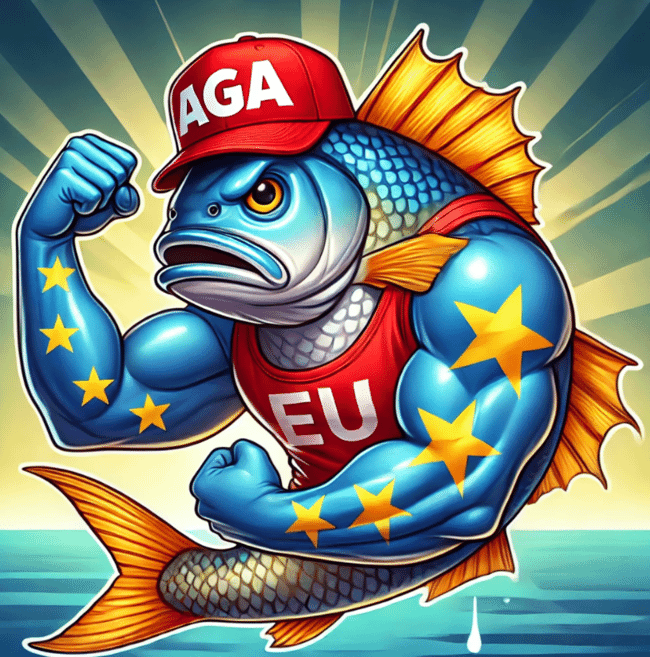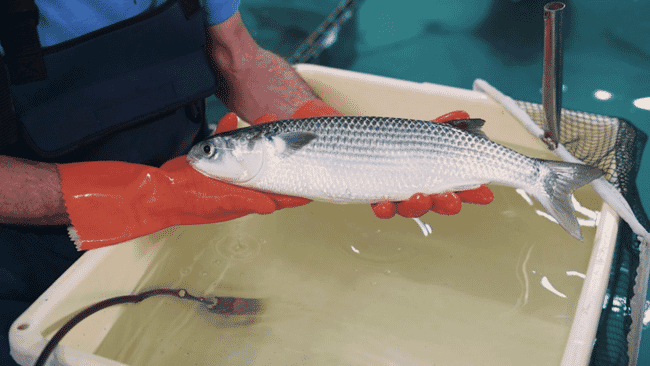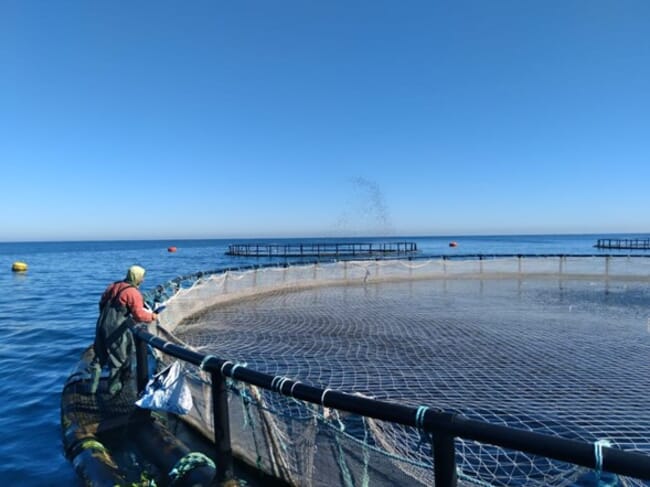
After China, the European Union (EU) is the world's largest single seafood market, valued at €62.3 billion in 2024. With a 68,000-kilometre coastline and a research sector that’s at the forefront of aquaculture innovation, the EU should have all the ingredients for a thriving aquaculture industry.
Yet in practice, EU aquaculture has been caught in a toxic mix of overregulation, stringent environmental laws, high labour costs and relentless competition from cheap seafood imports. Making it nearly impossible to start a new hatchery or farm, let alone turn a profit.
The latest AIPCE EU Seafood Supply Synopsis 2024 underscores the EU’s challenging seafood landscape: the total live weight of seafood production from aquaculture within the EU declined from its peak in 2017 at 1,370,000 tonnes, to just 1,139,000 tonnes in 2024. Seafood imports in the same year added up to 8,395,000 tonnes.
In other words, for every kilogram of seafood produced within the EU through aquaculture, a staggering 7.37 kg was imported. On a brighter note, if we put the right measures and mindset in place to substitute these imports with produce from local aquaculture, this imbalance provides an opportunity to potentially expand aquaculture production within the EU sevenfold. This will, however, only happen if the industry is willing to restore its ambition and competitiveness, and takes the lead in challenging the current status quo.
I would like to share three bold ideas to kickstart the discussion of turning this opportunity into reality:
1. Shifting the bureaucratic burden away from farmers
By encouraging local or regional level government units across the EU to allocate specific areas for aquaculture, modelled on the FAO’s Allocated Zones for Aquaculture (AZA) concept, a big share of the cumbersome bureaucracy can be taken away from the farmers. These Blue Business Zones are proposed to undergo the required environmental impact assessments (EIA) and public consultation process upfront under the responsibility of the local government unit. The expenses for this process could be covered by local governments as an investment towards attracting business and employment opportunities.
A pre-set carrying capacity and species-production system mix for each zone would be defined by the outcome of the EIA and public consultation process. The only requirement that would remain for the farmer is to apply for an operational permit with the local government. To further increase efficiency, a fixed short window could be set to process new applications.
Streamlining this permitting process and reducing waiting times would lower entry barriers significantly. This is especially important for budget-strained start-ups and small- and medium-sized enterprises (SMEs); both of which tend to bring most innovation to the sector. Doing so would also result in easier access to finance since the most pressing concern of institutional and private equity investors, i.e. the non-transparent and extremely lengthy bureaucratic process of getting farm permits in place is no longer the responsibility of the farmer.
This practical approach to deregulation, by establishing pre-approved aquaculture parks and one-stop permitting shop, is already in practice across Asia, as well as in Turkey and Australia, where they have not only spurred production and innovation, but also reinstated local SMEs as the cornerstones of healthy, future-proof economies.
A good example of the AZA concept already at work within the EU, although not defined as such, is provided in Puerto de Santa María, where in the face of declining fisheries catches, the Port Authority of the Bay of Cadiz has developed the local port into an attractive hub for aquaculture operators. Port authorities in Spain largely operate under their own jurisdiction and, as the port already had its permits in place, it was able to attract investors by offering a relatively quick and straightforward process to lease available space. The small port now boasts a world-famous Seriola hatchery operated by FutunaBlue, which recently also initiated the construction of a RAS growout facility together with Kingfish Norway. Fitoplancton Marino operates a high-tech algae production facility, The Aquaculture Technology Centre of Andalusia also established its headquarters on the site, while another group of investors is working on constructing an intensive RAS sole farm. Besides creating multiple synergies for all operators on the site, the creation of this special zone for aquaculture has generated significant local employment and revenues.
While the first official EU Blue Business Zones would most likely be located in coastal locations, there should also be a strong focus on developing offshore equivalents, as we should accept that the future of cage farming lies there. Land-based zones should also be established to facilitate hatcheries, nurseries, RAS growout facilities, processing plants and feed mills.
In line with the EU’s Green Deal, attention should also be given to the development of zones that focus on the production of low-trophic species with a net-positive footprint – like mussels, sea cucumbers, seaweeds and mullet. Meanwhile zones located near sensitive habitats or protected areas could focus on integrated multi-trophic aquaculture (IMTA) systems. To demonstrate how aquaculture farms can have a net-positive impact on their surrounding environment, the establishment of these most sustainable Blue Business Zones could be financially supported by NGOs, or even the EU.

© Dagon
An example of how this can work comes from Australia, where the regional government has developed Aquaculture Development Zones, which it refers to as a “investment-ready platforms for large-scale aquaculture operators, with environmental approvals and management frameworks already in place”.
In 2017, the regional government of Western Australia started by developing two zones for the farming of marine finfish, both of which are now fully allocated. Thereafter it started a special 800-hectare zone focused on shellfish farming only. To provide an attractive proposition to start-ups and local SMEs, it also initiated the construction of a 40-million capacity multi-species spat hatchery near the site.
The project has already created 100 direct jobs, and this is likely to double once the site reaches it carrying capacity of 1,500 tonnes of shellfish annually, valued at roughly AUS $30 million.
The EU recognises the potential value of the AZA concept and in 2024 it funded a two-year project to develop plans to work on implementing Allocated Zones for Aquaculture, but with only academic partners and government agencies involved in the project, the results are likely to remain in the theoretical domain.
As such, the European industry should instead take the lead by developing a practical brochure-style Blueprint on Blue Business Zones that could be based on existing FAO guidelines for the establishment of coastal zones dedicated to aquaculture in the Mediterranean and the Black Sea. This document should highlight the opportunities for local employment generation and the creation of new revenue streams for local government units in rural areas. The blueprint should be made available in different languages and thereafter extensively promoted with local and regional government units across the EU, especially in coastal parts of the Mediterranean EU.
2. Rekindling the spirit of collaboration
In the early 1980s innovation in European aquaculture thrived by openly sharing discoveries and best practice. People like Dr Minkoff, and other aquaculture influencers such as Alan Cook, Ivar Warrer-Hansen, Professor Greg Lutz, Cristóbal Aguilera and Andrew Leingang still make hugely important contributions to global aquaculture development by sharing their expertise and insights freely on the internet.
But the landscape has shifted and modern-day entrepreneurs tend to guard their intellectual property (IP) closely, focusing on filing patents and maximising short-term shareholder value instead, often at the expense of broader industry progress. It has been well documented that this mainly enriches individuals and corporations at the expense of society, equality and innovation.
Aquaculture’s biggest challenges can only be solved by a return to this open spirit of collaboration and, as a first bold move, we should explore the development of a pan-EU AI farm manager and environmental monitor. The main assumption is that an AI model trained using the raw production data and system parameters of a single company will always be limited in its analytical abilities. However, a model that is continuously trained using the data of a large pool of farms, with a wide range of production systems and species, will become exponentially more powerful.
Although perhaps farfetched and unliberal, it makes sense to encourage all EU aquaculture companies to share their internal production data and parameters – in anonymised format – to develop this supreme AI farm manager. In return, all producers who have contributed would receive unrestricted access to using the system.
True, a strong framework for data security and governance will be critical and harmonising these incoming data streams would require significant effort. However, in return, this integrated tool could vastly improve operational efficiency, animal welfare, environmental sustainability and overall performance and would not only drive innovation, but also contribute significantly to restoring the competitiveness of the EU’s aquaculture sector.

3. Exporting European expertise to other shores
Once we have shifted the bureaucratic burden away from farmers, rekindled the spirit of collaboration and expanded production on the continent, we need to set our sights on the horizon. Instead of continuing to deplete Africa’s resources through questionable fishery agreements, why don’t we consider exporting our cutting-edge European expertise and contribute to building a strong aquaculture sector by joining hands with our neighbours in Africa?
After a sevenfold expansion in production, as proposed earlier, the carrying capacity of the EU’s existing aquaculture powerhouses – Spain, Italy and Greece – will have been reached. However, along the 9,444-kilometre coastline from Morocco to Syria, it is likely that both governments and local businesses would be interested in collaborating to further develop a strong and sustainable aquaculture sector.
Through The Union for the Mediterranean it should be possible to establish an agreement to construct a network of state-of-the-art hatcheries operated through joint ventures between European companies and local counterparts, in which the latter take the lead. This would boost local seafood production and processing and create opportunities for all involved. To reduce pressure on the world’s most overfished sea, excess production could potentially be released to restock the overfished local stocks, as extensively promoted by Ofer Berzak in collaboration with the Mediterranean Parliament.
Coordinated efforts to maintain high sustainability standards in grow-out production (for which the proposed AI farm monitor could be deployed) will enhance local employment, tax revenue generation and food security. Excess production can be exported to nearby markets in the Middle East and India – with little competition for European producers.
A call to action
I do not claim to have all the answers and perhaps I’m being naïvely optimistic. Yet, by challenging the prevailing narrative and proposing these unconventional ideas, I hope to spark a robust debate – one that moves us towards a much-needed renaissance in EU aquaculture.




